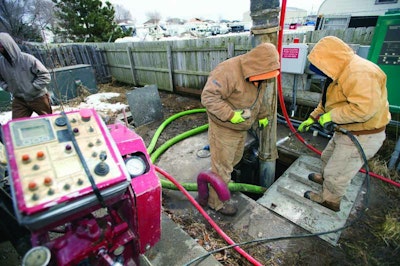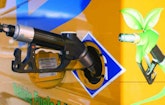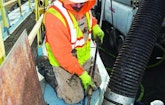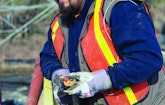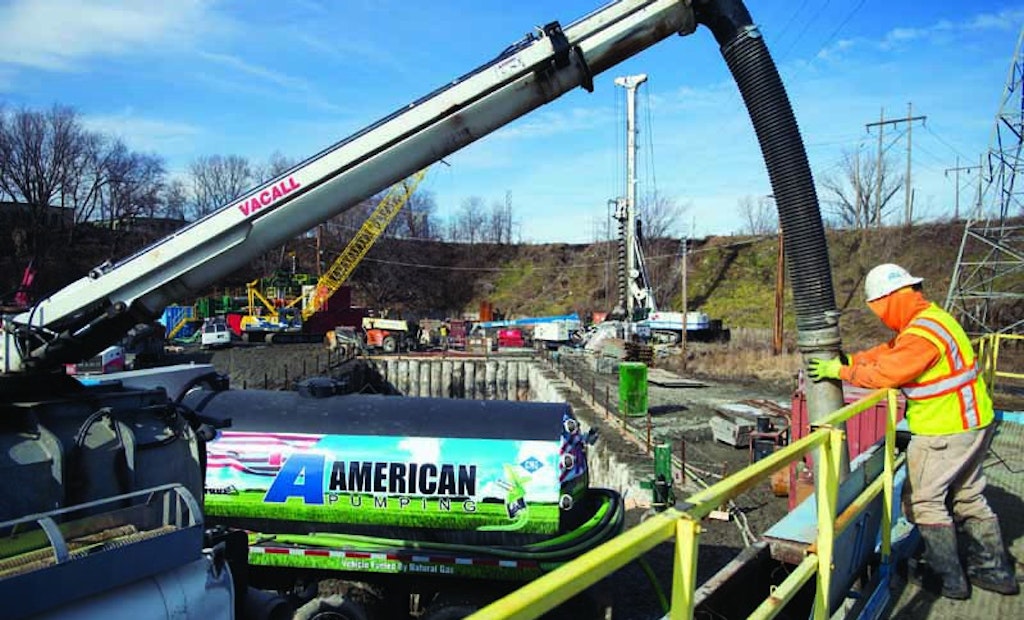
Interested in Cleaning?
Get Cleaning articles, news and videos right in your inbox! Sign up now.
Cleaning + Get AlertsWhen Mark and Sally Roseland bought Backlund Plumbing in 1987, the Omaha, Nebraska-based business was a small service shop with three employees. Today, it’s a multimillion-dollar-a-year company with 65 employees and a large array of trucks and equipment. The keys to this extreme makeover? The three D’s: Differentiation and diversity — and determination.
A good example of differentiation is the company’s fleet of compressed natural gas vehicles. The vehicles have not only saved the company tens of thousands of dollars during the last several years through reduced fuel costs, but also provide a “green” marketing angle that distinctively sets Backlund apart from its competitors. As for business diversity, the company offers a broad range of services, from residential and commercial plumbing and drain cleaning to municipal sewer and water work and septic tank pumping.
“We basically grew as our customers’ needs grew,” says Mark and Sally’s son, Chris, who joined the company in 1994 and became a master plumber in 2004. He now co-owns the company with his father. “We also made a decision years ago to try to offer as many services in-house as possible versus using subcontractors. We’ve always felt that we can maintain the quality of our work and do a better job if we control these jobs instead of relying on subcontractors.
“If someone calls with a problem at midnight, we show up with all our vehicles and we don’t have to wait for a sub to show up,” he adds. “We run a 24-hour operation — no answering service. If the phone rings at 2 a.m., we answer it. Same-day service is a huge must in our world. And we also have the equipment ready to handle virtually any problem; we’re a one-stop shop for plumbing, pumping, utility work and hydroexcavating. If people asked us to paint their house, we’d probably paint their house. ... We’ll literally do anything.”
Moreover, offering a variety of services avoids the all-eggs-in-one-basket problem that some companies run into, which leaves them vulnerable to market downturns, he says.
CNG conversions
Few things reflect the Roselands’ progressive business nature better than their fleet of more than two dozen CNG-powered vehicles. The conversion efforts began in 2012 with 10 Ford Econoline service vans used for drain cleaning and plumbing work. Today, natural gas also powers seven Ford Transit vans, two Dodge 2500 flatbed delivery trucks, three Freightliner FL70 service trucks, two vacuum trucks built on Freightliner M2 chassis and two dump trucks, featuring Freightliner FL70 chassis and 7-cubic-yard dump bodies, fabricated in-house.
High fuel prices played a key role in the decision to convert to CNG. In 2012, the average price for a gallon of gas nationwide hovered around $3.60. “At the time, we were doing work for the city’s Metropolitan Utility District (MUD) and I noticed they were converting their vehicles,” Roseland recalls. “So I inquired about it.”
Research showed that CNG at the time cost just $1.70 a gallon. In addition, natural gas prices historically aren’t subject to the volatile swings commonly seen in gasoline prices. And while the conversion price was expensive — about $12,000 per service van — MUD was offering a 50 percent rebate. That sealed the deal, Roseland says.
“With financial assistance from the rebates, our break-even point was running 3,000 gallons (of CNG) through the vehicles,” he explains. “Each van saved about $4,000 the first year through reduced fuel costs. I’d say 90 percent of those first 10 conversions paid for themselves within the first two or three years.”
Reduced operating expenses
Now that gas is just above $2 a gallon, the savings aren’t nearly as dramatic. But Roseland points out that since the vans’ conversions, the company also converted the two Freightliner dump trucks and other vehicles that use diesel fuel, which currently is about 50 cents per gallon more expensive than CNG. The cost of larger CNG-powered vehicles, such as the Freightliner dump trucks (which come with John Deere or Cummins CNG engines), is about $60,000 more than for a conventional truck. As such, the payback period is longer — about two years, he notes. “When diesel is at $4 a gallon and CNG is $2 a gallon, we might save up to $250 a day,” he explains.
“In my opinion, fuel prices eventually are going to go back up,” Roseland says. “Our vehicles have a seven- or eight-year life cycle, so we’re betting that fuel costs will average out higher in the next seven years.” In the short term, Roseland remains undaunted by lower fuel prices; the company plans to buy and convert five more Transit vans during 2016, he says.
Truck Center Companies does the CNG conversions. The process is relatively simple: The gas tank and fuel-delivery system is replaced with a CNG tank and a new fuel-delivery system. A different conversion kit enables the original gas engine to run on CNG, Roseland says.
Backlund’s revenues have increased since the CNG conversions, and he attributes much of it to the company’s ability to brand itself as a “green,” eco-conscious business. “I can verify that because we’ve only promoted it on our vinyl vehicle wraps, and when people call, they usually ask about the CNG trucks,” Roseland says. “They notice that we’ve done it. Our employees tell me that customers are always asking how it works. I think that if we’re on par with a competitor price-wise, we get chosen because we’re ‘greener.’”
There is one drawback to CNG-powered vehicles: Fueling stations are scarce. Roseland says the company is fortunate because there are two CNG stations within a mile of the company’s headquarters. In addition, all the CNG vehicles have only a 250-mile range, so drivers must always be aware of their proximity to fueling stations. “But they’re adding more refueling stations every year,” he notes.
Drain cleaning expansion
Backlund started offering drain cleaning services in the late 1990s, again in response to customer demands. “We used to sub it out to a drain cleaning company, but we wanted to keep our quality up to par and keep the revenue in-house,” Roseland explains. “It turned out to be a financial winner.”
As demand for drain cleaning services grew, so did the company’s roster of equipment. Today, the company owns two trailer-mounted Spartan 798 (4,000 psi at 18 gpm) water jetters equipped with 500-gallon water tanks and a 2010 Camel 1200 jet/vac truck (Super Products) with hydroexcavating capability. It features a 12-cubic-yard debris tank, a 1,500-gallon water tank, a Roots Systems blower (4,460 cfm) and a water pump (80 gpm at 2,000 psi) made by Myers.
In addition, the company relies on five cart-mounted drain cleaning machines made by Duracable Manufacturing, six VuTek push cameras made by Insight Vision Cameras for pipeline inspections, several RIDGID Mini-SeeSnake inspection cameras and a Dodge Sprinter camera truck equipped by CUES with a LAMP inspection camera that includes lateral-launch capability.
The company also owns a 2012 Vacall AllExcavate hydroexcavating truck, built on a Sterling chassis with a 12-cubic-yard debris tank, a 1,300-gallon water tank and a 5,150 cfm Hibon blower; and two trailer-mounted hydroexcavators made by Ditch Witch. Used primarily for utility potholing, the units feature 500-gallon debris tanks and 250-gallon water tank.
In addition, the company owns five mini-excavators and two skid-loaders made by Bobcat Co., three John Deere loaders and one Caterpillar excavator.
Owning a wide range of equipment helps Backlund land jobs that it otherwise couldn’t bid on. A good example is a massive, ongoing sewer rehabilitation project in Omaha, slated for completion in 2027. Known as Clean Solutions for Omaha, the project includes separating combined stormwater and sanitary sewer lines, which in turn will reduce the number of sewer system overflows that result in raw sewage discharges into the Missouri River and other local waterways.
“It’s been a real boon to our vac truck business,” Roseland says of the project, which also includes construction of a deep tunnel and underground detention basins to store excess stormwater during heavy rainfalls. “The detention basins have to be periodically cleaned of debris.”
But what happens if competitors start investing in vacuum trucks? Roseland says his employees’ skills and experience will still differentiate the company from competition. “We recently were hired to pump and remove solids that were located 50 feet underground, after another company failed with the same equipment,” he points out. “We used different fittings to increase airflow. ... Good operators are everything in the vac world. You can’t just turn on a switch and drop a hose in a pool of water.”
As for the future, Roseland says the company is aiming for 10 percent growth in sales during 2016, with much of the increase coming in sewer and water infrastructure work.
He also says acquiring another company isn’t out of the question. “We’re always thinking like that. We’re always willing to consider getting into something new."
Cross-Training Creates Happier, More Productive Employees
One of the keys to Backlund Plumbing’s exponential growth over the past couple decades is a cross-training program that enables employees to perform a variety of functions, which improves efficiency at the Omaha-based company.
At Backlund, some plumbers know how to operate a vac truck, for instance. In other instances, sewer line cleaners can also run inspection camera systems. And along the way, employees make themselves more valuable to the company — and sometimes even earn pay increases. “One of my best drain technicians became a full-time cross-bore CCTV technician,” says Chris Roseland, who co-owns the business his father, Mark, bought in 1987. “He got a substantial pay raise for acquiring a new skill.
“Cross-training is a big reason why we excel,” he adds. “We have very smart employees. One of our technicians likes to fix things, for example, so he learned how to repair pipeline inspection cameras. We also have interior commercial plumbers who want to be out in the dirt, digging. So they learn how to run excavating equipment. Then in winter, when there’s less digging going on, they can go back to doing interior plumbing again.”
Cross-training is time-consuming and requires thorough planning as well as a strong commitment. But in the end, it’s worth the time invested, Roseland says, and not just because of the increased efficiencies. He points out that employees appreciate their employers more when they feel the company is interested in satisfying their career goals. As such, cross-training can reduce turnover as well as keep employees refreshed.
“I think our employees are happier because on most days, they never know what they’ll be doing. We’re as far from an assembly-line job as you can get,” Roseland says. “Doing different things keeps them invigorated about their jobs and helps to prevent burnout.”
Backlund also improves retention by paying top wages and offering good benefits, such as providing more paid time off and a matching 401(k) retirement program, plus paying the bulk of employee health insurance premiums. “When people came to work for us 10 years ago, they came because we could give them 60- to 70-hour weeks and enable them to make more money,” Roseland points out. “Now they seem to prefer that we offer a 40- or 50-hour workweek, pay them a good wage and back it all up with a good benefits package.”
To build company loyalty and teamwork, Backlund also holds special events for employees, like Thursday night bowling-and-pizza parties or fishing/hunting trips. “Once we took 50 guys to a Kansas City Chiefs game,” Roseland says. “We treat employees like gold because they’re our most valuable asset.
“In 2015, we went from $8 million to $10 million in sales — with the same number of employees,” he adds. “I never thought we could top $10 million in sales. But we did it, thanks to diversified services and cross-trained employees.”
